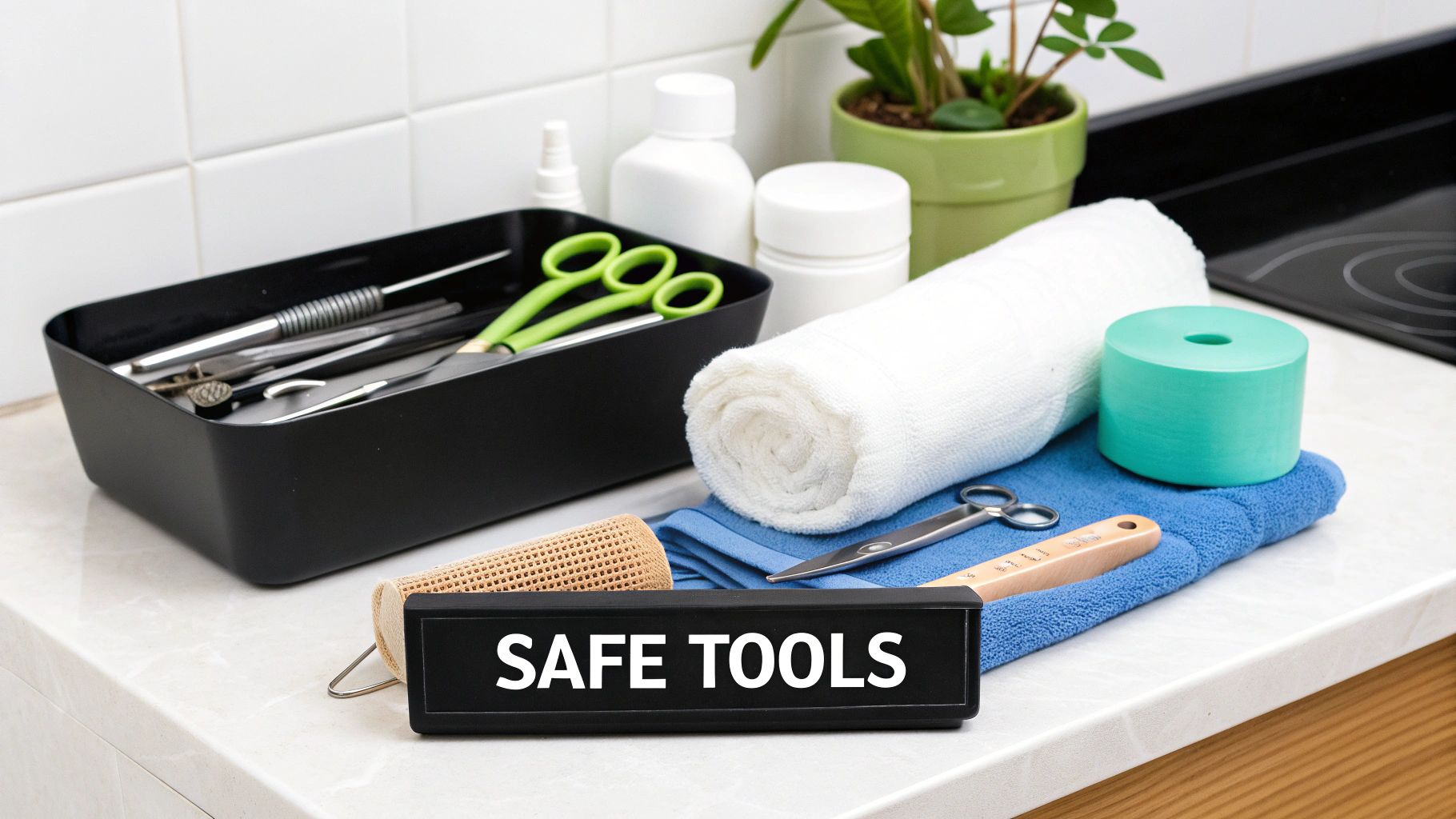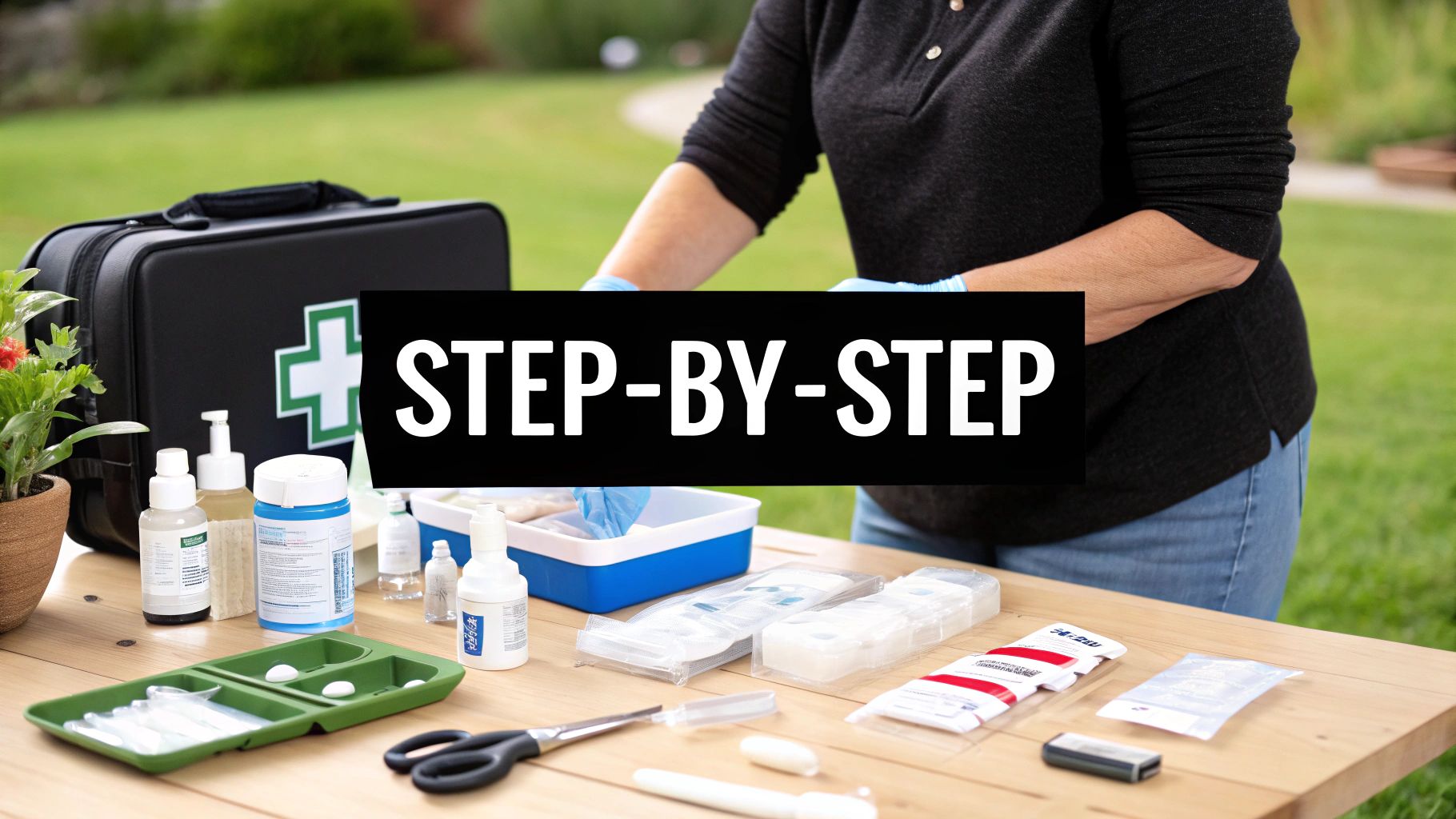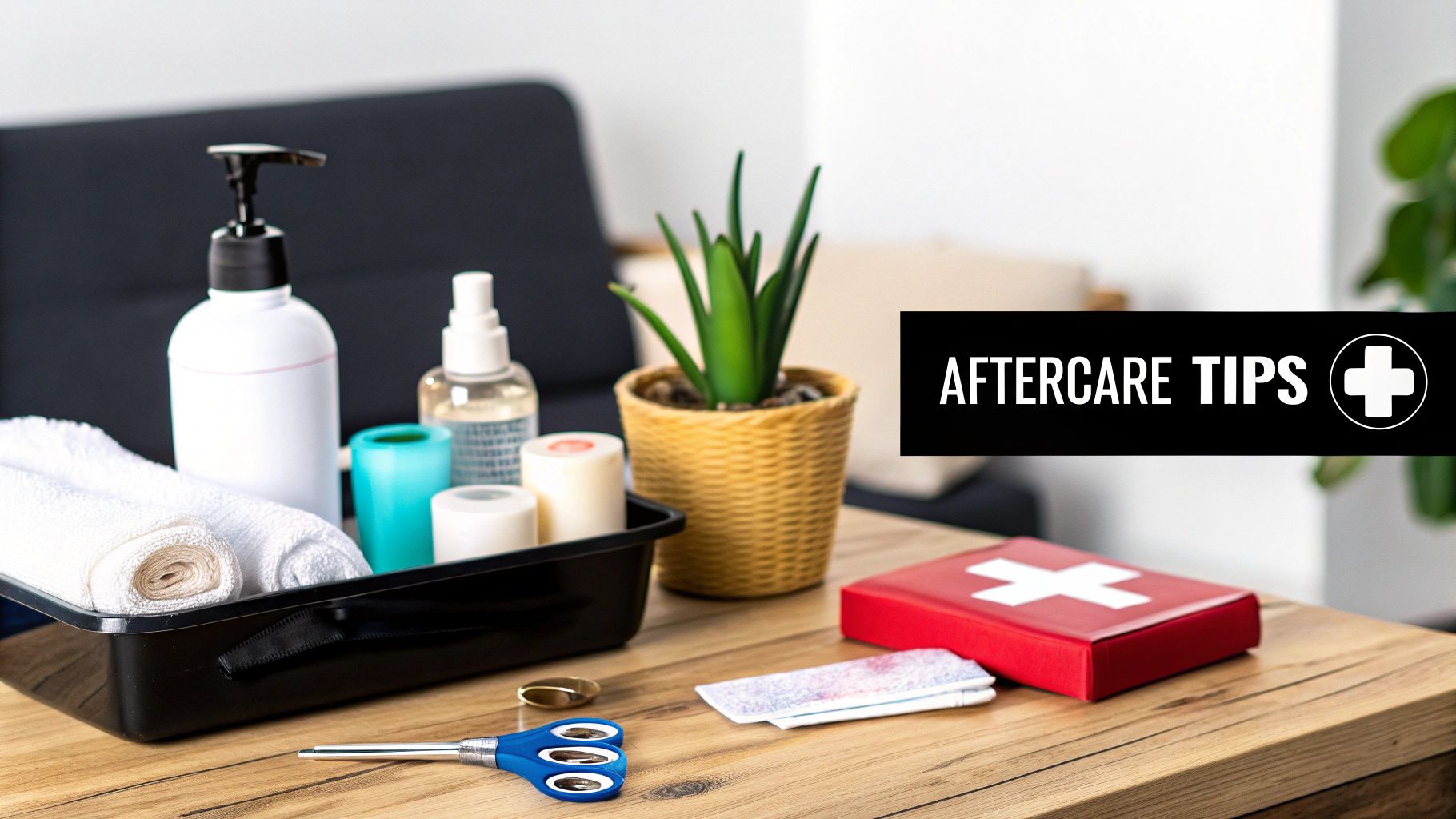The Essential Guide to Wound Debridement at Home
Wound debridement at home can seem intimidating, but with the proper information and techniques, it can be a safe and effective method for managing specific wounds. This process involves removing dead, damaged, or infected tissue to encourage healing. It’s not always required, so knowing which wounds can benefit from at-home debridement is essential. Minor cuts, scrapes, and abrasions are often suitable for this type of care.
Understanding the Importance of Wound Debridement
Debridement is vital because it helps create a clean wound bed. This clean environment allows healthy new tissue to develop, speeding up the healing process and reducing the risk of infection. It’s similar to tending a garden – removing dead leaves and branches promotes new growth. This process is particularly crucial for chronic wounds, where the presence of dead tissue can seriously impede healing.
Proper wound debridement can also enhance the effectiveness of other treatments like topical medications and dressings. For instance, a clean wound bed allows medications to penetrate more effectively and dressings to function optimally. This ultimately contributes to better healing outcomes.
The Rise of At-Home Debridement
The growing availability of over-the-counter (OTC) products has made at-home wound debridement more prevalent. The global wound debridement market, which includes both professional and at-home products, was valued at USD 4.45 billion in 2022. It’s projected to reach USD 7.17 billion by 2030. Grand View Research provides more information on this market.
The OTC segment is anticipated to experience the most rapid expansion, with a CAGR of 6.5% between 2023 and 2030. This growth is primarily due to the convenience of buying wound debridement products online, making it simpler for people to manage minor wounds at home.
Identifying Wounds Suitable for At-Home Care
Although many minor wounds can be treated at home, knowing when professional medical help is necessary is crucial. Deep wounds, heavily bleeding wounds, or wounds showing signs of infection (like increased pain, redness, swelling, or pus) require a healthcare professional’s evaluation.
This is particularly important for those with underlying health conditions such as diabetes, which can complicate wound healing. For example, a small foot wound in someone with diabetes can rapidly become serious without proper medical care. Prompt medical attention can prevent these small wounds from developing into major complications.
Setting Realistic Expectations for Healing
Understanding the typical healing timeframe for various wound types is important for managing expectations. Superficial wounds might heal in a few days, while deeper wounds can require weeks or even months. Factors like age, overall health, and the wound’s location all influence healing time.
Patience is vital during the wound healing process. It’s essential to adhere to proper care guidelines to minimize complications and ensure the best possible results. This usually includes regular cleaning, appropriate dressing changes, and watching for any signs of infection. This diligent care contributes to faster, more complete healing.
Proven Methods for Safe Wound Debridement at Home

Effective wound debridement at home involves more than just cleaning. It requires specific techniques to safely remove damaged tissue and encourage healing. This section explores various evidence-based methods for at-home wound debridement, from mechanical debridement with wet-to-dry dressings to using enzymatic debridement agents.
Autolytic Debridement: Your Body’s Natural Healing Power
Autolytic debridement is the gentlest method, using your body’s enzymes and fluids to break down dead tissue. This method is best for wounds with minimal drainage and no infection. Think of it as your body’s own clean-up crew.
To perform autolytic debridement at home, you’ll need moisture-retaining dressings like hydrogels or hydrocolloids. These dressings create a moist environment that promotes the body’s natural debridement process. They also soften the dead tissue, making it easier to remove during dressing changes.
Mechanical Debridement: Wet-to-Dry Dressings
Mechanical debridement physically removes dead tissue. A common method is using wet-to-dry dressings. This involves applying a damp (not wet) gauze pad to the wound, letting it dry, and then carefully removing it. The dried gauze adheres to the dead tissue, pulling it away with the dressing.
This method can be slightly more uncomfortable than autolytic debridement but is effective for wounds with moderate dead tissue. Be careful to avoid scrubbing, which can damage healthy tissue. Gentle, precise movements are key.
Enzymatic Debridement: A Targeted Solution
Enzymatic debridement uses topical ointments containing enzymes that break down dead tissue. These over-the-counter ointments are a good option for wounds with significant dead tissue or those not responding to other methods.
While effective, enzymatic debridement isn’t suitable for all wounds or people with sensitive skin. Follow product instructions and consult a healthcare professional if you have any questions.
Irrigation: Cleansing the Wound
Irrigation is crucial for all wound debridement methods. It involves gently flushing the wound with sterile saline solution (salt water) to remove debris and bacteria. Proper irrigation prevents infection and creates a clean wound bed for healing.
Use a syringe or a specialized wound irrigation bottle to deliver the saline. Use gentle pressure to avoid further damage. The goal is to cleanse without disrupting healthy tissue.
Choosing the Right Debridement Method
The best method depends on the wound type and severity, your health, and comfort level. Consult a healthcare professional for personalized guidance. They can assess your situation and recommend the most appropriate approach.
To help you choose, here’s a comparison of the methods we’ve discussed:
Wound Debridement Methods Comparison
A detailed comparison of different home debridement methods, their appropriate uses, effectiveness, and safety considerations.
| Method | Best For | Ease of Use | Required Materials | Precautions |
|---|---|---|---|---|
| Autolytic Debridement | Wounds with minimal drainage and no infection | Easy | Hydrogel or hydrocolloid dressings | Not suitable for infected wounds |
| Mechanical Debridement (Wet-to-Dry) | Wounds with moderate amounts of dead tissue | Moderate | Gauze pads, saline solution | Can be uncomfortable; avoid scrubbing |
| Enzymatic Debridement | Wounds with significant dead tissue or those unresponsive to other methods | Moderate | Enzymatic ointment | May not be suitable for all wound types or sensitive skin; follow product instructions |
| Irrigation | All wound types as part of debridement | Easy | Sterile saline solution, syringe or irrigation bottle | Use gentle pressure to avoid damage |
This table summarizes the key features of each method to help you understand which might be best for your needs. Always consult with a healthcare professional for personalized recommendations.
Advancements in At-Home Wound Debridement
Advancements in at-home wound debridement are growing, driven by factors like an aging population and the rise of chronic diseases. Innovations like portable negative pressure wound therapy (NPWT) devices offer patients more independence in managing their wounds at home. Explore this topic further
Building Your Essential Wound Debridement Kit

Having the right supplies on hand is crucial for effective wound debridement at home. This involves putting together a well-stocked kit with everything necessary for safe and efficient wound care. This guide will walk you through creating a comprehensive home debridement kit, emphasizing both quality and affordability.
Essential Supplies For Your Kit
Much like a chef needs specific tools, proper wound care requires specialized supplies. These items ensure you can effectively clean, debride, and dress your wound:
-
Sterile Gloves: Protecting yourself and the wound from infection is paramount. Always wear sterile gloves during any wound care procedure.
-
Saline Solution: Normal saline is the preferred choice for wound irrigation. It gently cleanses without damaging tissue. Avoid using tap water due to potential impurities.
-
Gauze Pads: These versatile pads are used for cleaning, applying solutions, and packing wounds. Opt for sterile, non-woven gauze for the best results.
-
Irrigation Syringe or Bottle: A syringe or specialized irrigation bottle allows for controlled and gentle wound cleansing, helping remove debris and bacteria.
-
Moisture-Retaining Dressings: For autolytic debridement, dressings like hydrogels and hydrocolloids are essential. They maintain a moist wound environment, which promotes natural healing.
-
Enzymatic Ointment (Optional): If your doctor recommends it, an enzymatic ointment can help break down dead tissue. Follow the product instructions carefully.
-
Adhesive Bandages: Secure dressings with appropriate adhesive bandages. Choose breathable and skin-friendly options.
-
Scissors: Keep clean scissors specifically for wound care to cut gauze and bandages.
-
Waste Disposal Bag: Dispose of used materials in a designated bag for hygiene. Maintaining a clean environment is key for wound healing; for tips on natural drain cleaning, check out How to Unclog Shower Drain Naturally.
Organizing Your Wound Debridement Kit
Just like a well-organized toolbox, your wound care kit should be easily accessible and sterile. Consider these organizational tips:
-
Designated Container: Store your supplies in a clean, waterproof container to protect them from contamination.
-
Label Everything Clearly: Clear labels ensure you quickly find what you need and avoid confusion.
-
Check Expiration Dates: Regularly check expiration dates and replace outdated items.
-
Restock Promptly: Replenish used supplies promptly to stay prepared.
Cost-Effective Options For Quality Supplies
Creating a complete wound debridement kit doesn’t have to break the bank. Many pharmacies and online retailers offer affordable, high-quality supplies. Compare prices and consider store brands, which can offer similar quality at lower prices. For personalized advice on supplies and cost-effective choices, contact Rapid Wound Care for insights based on patient experiences and wound management expertise.
By following these guidelines, you can assemble a wound debridement kit that empowers you with the tools and knowledge for safe and effective wound care at home. Always consult with a healthcare professional for personalized recommendations and guidance. They can help you choose the right supplies and methods for your specific needs.
Connecting With Professionals: Telemedicine for Wound Care

Wound care has evolved beyond traditional clinic visits. Telemedicine offers valuable support and monitoring, especially for individuals managing wound debridement at home. This approach allows patients to connect with healthcare professionals remotely, ensuring effective wound management.
Enhancing Remote Wound Assessment Through Technology
Telemedicine utilizes various technologies for remote wound evaluation. High-quality smartphone cameras have become essential tools, allowing patients to capture clear images of their wounds. These photos enable healthcare professionals to assess progress without requiring an in-person examination.
Beyond standard photographs, some telemedicine platforms integrate specialized wound tracking apps. These apps often feature measurement tools and progress logs. This data provides valuable insights for both patients and clinicians, tracking wound size and documenting any changes in appearance.
Preparing for a Virtual Consultation
Similar to in-person visits, preparation is crucial for a productive telemedicine consultation. Gathering wound care supplies, pertinent medical information, and a list of questions beforehand ensures efficient use of time with the clinician.
Furthermore, adequate lighting and a stable internet connection are essential for a smooth, uninterrupted virtual consultation. Choosing a quiet, private space allows for comfortable discussion of wound care needs without distractions.
Essential Information to Share During Remote Assessments
Sharing specific details during virtual consultations helps clinicians understand the wound’s condition. Clear descriptions of any pain, changes in drainage or odor, and the surrounding skin’s appearance are crucial. This comprehensive information enables informed decisions about your care.
Also, be prepared to discuss your current debridement method, dressing change frequency, and any concerns. Open communication is vital for successful telemedicine wound care, ensuring patient and clinician alignment on the treatment plan. The COVID-19 pandemic highlighted challenges in wound care access, with only 22.6% of patients continuing regular wound clinic visits. Learn more about wound debridement market challenges.
Recognizing the Limits of Virtual Care
While telemedicine provides convenience, it does have limitations. Healthcare providers cannot physically examine the wound through a screen. Some situations require in-person evaluations, such as deep wounds, significant bleeding, signs of infection, or unexplained pain.
Knowing when virtual care is sufficient and when in-person intervention is necessary is crucial for effective wound management. Collaborating with your healthcare provider and understanding telemedicine’s limitations enables safe and effective use of this technology within your wound care plan.
When to Stop: Critical Warning Signs During Home Debridement
Even with the right techniques for wound debridement at home, knowing when to seek professional medical help is crucial. This section outlines the warning signs that indicate a need for immediate medical intervention. Understanding these signs can prevent serious complications and ensure the wound heals properly.
Recognizing Concerning Developments
Some discomfort is a normal part of the healing process, but certain changes warrant closer attention. Spreading redness around the wound, especially if it extends beyond the initial injury, can indicate an infection. Unusual odors, particularly foul or pungent smells coming from the wound, are also a red flag.
Changes in drainage are another important indicator. An increase in the amount of drainage, a change in its color (like yellow, green, or brown), or the development of thick, pus-like drainage all signal a potential problem. These signs suggest the wound isn’t healing properly and may be infected.
Practical Tracking Methods for Early Detection
Early identification of negative trends is crucial for effective wound management. Simple measurements, such as using a ruler to track the wound’s size, can reveal if it’s getting bigger instead of smaller. Regularly documenting these measurements provides a clear picture of the wound’s progress.
Photo documentation is another helpful tool. Taking regular pictures of the wound, under the same lighting conditions each time, allows you to see subtle changes you might otherwise miss. These photos, combined with your measurements, offer valuable information for healthcare professionals, giving them a visual history of the wound.
Warning Signs That Demand Immediate Action
Some warning signs require immediate medical attention. These include a high fever (over 100.4°F or 38°C), chills, increasing pain, numbness or tingling around the wound, and red streaks radiating out from the wound site. These symptoms can indicate a serious infection needing prompt treatment.
If the wound begins bleeding excessively or shows no signs of improvement after several days of home care, seek professional help. Telemedicine is one option for professional guidance. Quick intervention can prevent serious complications and ensure the best possible outcome.
Before we discuss the importance of timely intervention, let’s look at a table summarizing the key warning signs to watch out for during home wound care.
Warning Signs During Home Wound Care: This table lists key indicators that signal when to discontinue home debridement and seek immediate medical attention.
| Warning Sign | Description | Action Required | Urgency Level |
|---|---|---|---|
| Spreading Redness | Redness extending beyond the initial wound area | Contact healthcare provider | High |
| Unusual Odor | Foul or pungent smell from the wound | Contact healthcare provider | High |
| Increased Drainage | Significant increase in the amount of drainage | Contact healthcare provider | High |
| Change in Drainage Color | Drainage turns yellow, green, or brown | Contact healthcare provider | High |
| Thick, Pus-like Drainage | Development of pus in the wound | Contact healthcare provider | High |
| High Fever | Temperature over 100.4°F (38°C) | Seek immediate medical attention | Urgent |
| Chills | Experiencing chills or shivering | Seek immediate medical attention | Urgent |
| Increasing Pain | Wound pain becomes more severe | Contact healthcare provider | High |
| Numbness/Tingling | Loss of sensation or tingling around the wound | Seek immediate medical attention | Urgent |
| Red Streaks | Red lines radiating from the wound | Seek immediate medical attention | Urgent |
| Excessive Bleeding | Uncontrolled bleeding from the wound | Seek immediate medical attention | Urgent |
| Lack of Improvement | No visible improvement after several days of home care | Contact healthcare provider | Medium |
As you can see, a variety of warning signs indicate the need for professional medical evaluation. Recognizing these signs is the first step towards ensuring proper healing and preventing potential complications.
The Importance of Timely Professional Intervention
Real-world examples demonstrate the significant impact of timely intervention. One patient managing a small foot wound at home noticed spreading redness and increased pain. Seeking prompt medical care allowed them to receive appropriate treatment, preventing a severe infection and possible amputation.
Another patient with a chronic wound observed an unusual odor and changes in drainage. Seeking professional help led to the diagnosis of a previously undetected infection, which was then treated successfully. These cases highlight the importance of recognizing warning signs and seeking timely professional intervention for optimal wound healing. Delaying treatment can lead to more extensive interventions and a longer recovery period.
Mastering Chronic Wound Care at Home
Chronic wounds, such as diabetic ulcers, pressure injuries, and venous stasis ulcers, present ongoing challenges. These wounds demand consistent and dedicated management. This section explores evidence-based strategies for chronic wound care at home. Successfully managing these wounds involves a multifaceted approach. This includes understanding how at-home care complements professional treatment, optimizing nutrition, and using specialized techniques for the long term.
Integrating Home Debridement With Professional Treatment
Some aspects of wound debridement can be performed at home. However, coordinating these efforts with a healthcare professional is critical. This collaborative approach ensures the chosen methods align with the overall treatment plan and the wound’s specific characteristics. For example, a physician might recommend enzymatic debridement for one ulcer but advise against mechanical debridement due to fragile skin. Regular communication with your healthcare provider, including photos and measurements, allows for adjustments based on progress.
The Role of Nutrition in Tissue Regeneration
Proper nutrition is essential for wound healing. The body needs specific nutrients to repair damaged tissue, much like a building requires strong materials. A diet rich in protein, vitamins A and C, and zinc is vital for cell growth and collagen production. This means incorporating foods like lean meats, colorful fruits and vegetables, and whole grains. Adequate hydration also plays a crucial role. It maintains skin elasticity and helps deliver these nutrients to the wound.
Specialized Techniques for Long-Term Wound Management
Managing chronic wounds often involves specialized techniques tailored to the wound type. Compression therapy, for instance, is essential for venous stasis ulcers. It helps reduce swelling and improve blood flow. This often involves wearing compression bandages or stockings as prescribed. For pressure injuries, frequent repositioning and pressure-relieving cushions are crucial to prevent further damage.
Managing Underlying Conditions and Setting Realistic Expectations
Chronic wounds are often linked to underlying health conditions like diabetes. Managing these conditions effectively is key to successful wound healing. For individuals with diabetes, maintaining stable blood sugar is vital for the body’s ability to repair tissue. Setting realistic healing expectations is also important. Chronic wounds can take time to heal, requiring patience and adherence to the treatment plan.
The Psychological Impact of Chronic Wounds
Living with a chronic wound can impact mental well-being. Ongoing pain, discomfort, and limitations can lead to frustration, anxiety, or even depression. Discussing these challenges with healthcare professionals and support groups can be beneficial. Connecting with others who understand these difficulties provides valuable emotional support. Maintaining motivation throughout the healing process is key to a successful outcome.
For comprehensive at-home wound care services, tailored treatment plans, and support, contact Rapid Wound Care. Their team of certified professionals provides personalized care for chronic wounds, helping patients achieve optimal healing.

